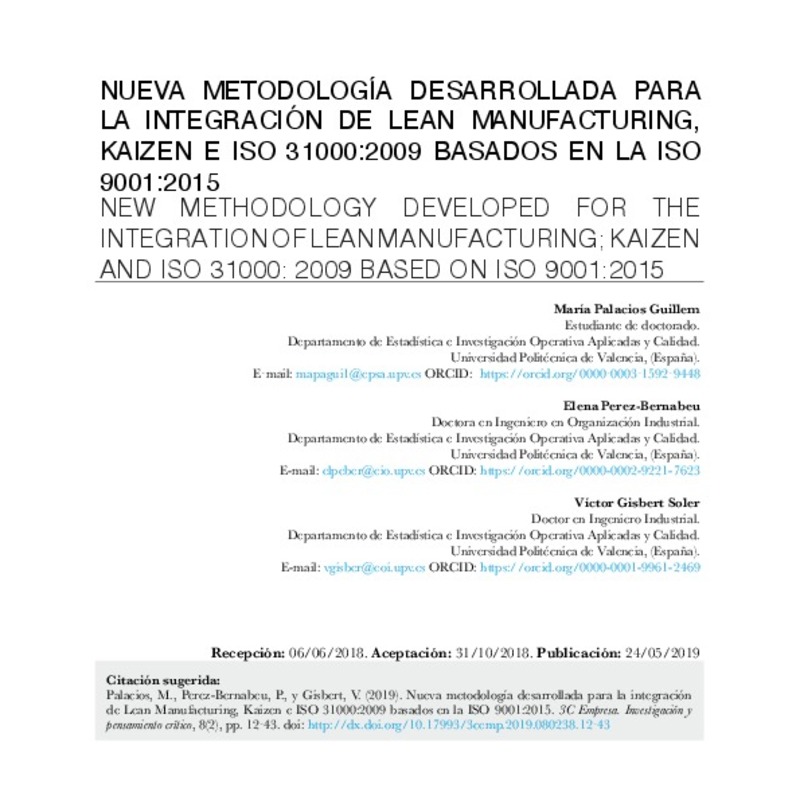JavaScript is disabled for your browser. Some features of this site may not work without it.
Buscar en RiuNet
Listar
Mi cuenta
Estadísticas
Ayuda RiuNet
Admin. UPV
Nueva metodología desarrollada para la integración de Lean Manufacturing, Kaizen e ISO 31000:2009 basados en la ISO 9001:2015
Mostrar el registro sencillo del ítem
Ficheros en el ítem
| dc.contributor.author | Palacios Guillem, María
|
es_ES |
| dc.contributor.author | Pérez Bernabeu, Elena
|
es_ES |
| dc.contributor.author | Gisbert Soler, Víctor
|
es_ES |
| dc.date.accessioned | 2021-01-19T04:32:17Z | |
| dc.date.available | 2021-01-19T04:32:17Z | |
| dc.date.issued | 2019-05-24 | es_ES |
| dc.identifier.uri | http://hdl.handle.net/10251/159349 | |
| dc.description.abstract | [EN] The main objective of the article is to create a methodology that integrates the Kaizen, Lean Manufacturing and the ISO 31000 and ISO 9001 standards. With this methodology, what is intended is to help SMEs to generate quality, continually improving and eliminating everything does not generate value. For this, a search of the existing methodologies was made and a descriptive analysis of a series of data obtained through the submission of a questionnaire to SMEs in the Valencian Community was carried out. From this descriptive analysis it is obtained that the SMEs in the sample have opted to use an analysis of the common elements of the systems or a model specific to the organization. With the descriptive analysis, it is also known that the duration of the integration of the systems lasted between 1 and 2 years and that the elements that most integrated the SMEs were ¿Processes to which the integration will be applied¿ and the "Degree of compliance with the requirements of the different management systems and the degree of compliance expected with the integration". | es_ES |
| dc.description.abstract | [ES] El presente artículo tiene como objetivo principal crear una metodología que integre Kaizen, Lean Manufacturing y las normas ISO 31000 e ISO 9001. Con dicha metodología lo que se pretende es ayudar a las pymes a generar calidad, mejorando continuamente y eliminando todo aquello que no genera valor. Para ello se realizó una búsqueda de las metodologías existentes y se llevó a cabo un análisis descriptivo de una serie de datos obtenidos a través del envío de un cuestionario a pymes de la Comunidad Valenciana. De dicho análisis descriptivo se obtiene que las pymes de la muestran han optado por emplear un análisis de los elementos comunes de los sistemas o un modelo propio de la organización. Con el análisis descriptivo, también, se conoce que la duración de la integración de los sistemas duró entre 1 y 2 años y que los elementos que más integraron las pymes fueron ¿Procesos a los que se va a aplicar la integración¿ y el ¿Grado de cumplimiento de los requisitos de los diferentes sistemas de gestión y el grado de cumplimiento esperado con la integración¿. | es_ES |
| dc.language | Español | es_ES |
| dc.publisher | Area de Innovacion y Desarrollo, S.L. - 3 Ciencias | es_ES |
| dc.relation.ispartof | 3C Empresa, Investigación y pensamiento crítico | es_ES |
| dc.rights | Reserva de todos los derechos | es_ES |
| dc.subject | Metodología de integración | es_ES |
| dc.subject | ISO 9001 | es_ES |
| dc.subject | ISO 14001 | es_ES |
| dc.subject | Lean Manufacturing | es_ES |
| dc.subject | Kaizen | es_ES |
| dc.subject | Integration methodology | es_ES |
| dc.subject.classification | ESTADISTICA E INVESTIGACION OPERATIVA | es_ES |
| dc.title | Nueva metodología desarrollada para la integración de Lean Manufacturing, Kaizen e ISO 31000:2009 basados en la ISO 9001:2015 | es_ES |
| dc.title.alternative | NEW METHODOLOGY DEVELOPED FOR THE INTEGRATION OF LEAN MANUFACTURING; KAIZEN AND ISO 31000: 2009 BASED ON ISO 9001:2015 | es_ES |
| dc.type | Artículo | es_ES |
| dc.identifier.doi | 10.17993/3cemp.2019.080238.12-43 | es_ES |
| dc.rights.accessRights | Abierto | es_ES |
| dc.contributor.affiliation | Universitat Politècnica de València. Departamento de Estadística e Investigación Operativa Aplicadas y Calidad - Departament d'Estadística i Investigació Operativa Aplicades i Qualitat | es_ES |
| dc.description.bibliographicCitation | Palacios Guillem, M.; Pérez Bernabeu, E.; Gisbert Soler, V. (2019). Nueva metodología desarrollada para la integración de Lean Manufacturing, Kaizen e ISO 31000:2009 basados en la ISO 9001:2015. 3C Empresa, Investigación y pensamiento crítico. 8(2):13-43. https://doi.org/10.17993/3cemp.2019.080238.12-43 | es_ES |
| dc.description.accrualMethod | S | es_ES |
| dc.relation.publisherversion | https://doi.org/10.17993/3cemp.2019.080238.12-43 | es_ES |
| dc.description.upvformatpinicio | 13 | es_ES |
| dc.description.upvformatpfin | 43 | es_ES |
| dc.type.version | info:eu-repo/semantics/publishedVersion | es_ES |
| dc.description.volume | 8 | es_ES |
| dc.description.issue | 2 | es_ES |
| dc.identifier.eissn | 2254-3376 | es_ES |
| dc.relation.pasarela | S\372795 | es_ES |








